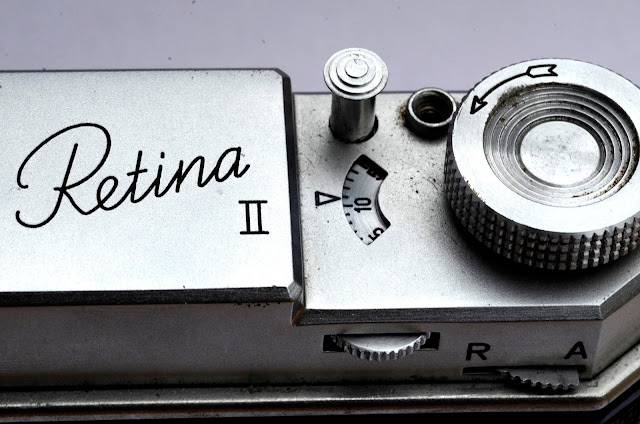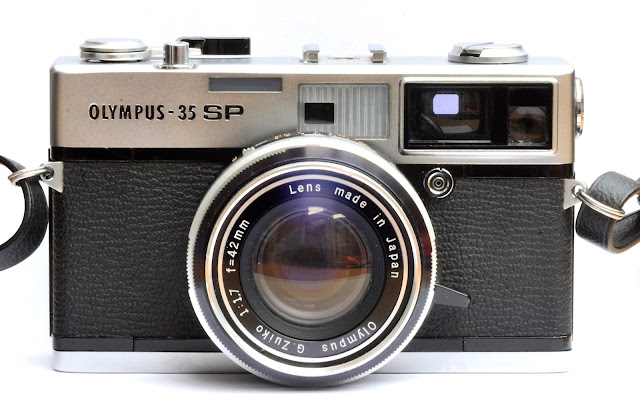Kodak Retina II - Type 011
One of the advantages of working for Kodak is that I get to see our new technology ahead of its release. I also have access to archives and information about our products. As I spent 26 years in research and development I also have a good idea about the science behind analogue photography. Another advantage is access to cameras such as the Kodak Retina II which I'm writing about here.
The example I'm using is from a display case in my office. It was made in Stuttgart in 1946. It still has the hand written, in ink, label attached to it and references the Nagel Camerawerks who produced it for Kodak. Nagel was bought by Kodak in 1931 and became Kodak AG. The camera came to the UK a couple of years ago when our Stuttgart office was being tidied up. It probably hasn't been used much, if at all. Let's see what it has got going for it.
The Kodak Retina II Type 011 was made by Kodak in Stuttgart between 1946 and 1949. It is a metal bodied 35mm camera with fold away lens. The model I have comes with a Compur-Rapid shutter with exposure of 1 second to 1/500th second plus Bulb. The lens is a 50mm f2 Schneider-Kreuznach Xenon. The Retina II was also available with Kodak Ektar f2 47mm or Rodenstock Heligon f2 50mm lenses.
The camera is fairly small and compact and with the lens folded away it easily fits in a coat pocket. What is noticeable though is its weight. The camera is obviously made from some serious metal. It also feels like a quality item. It may be a bit of a cliche but this is some seriously good German engineering. The camera is 72 years old. Everything on it works and all moving parts are still tight and operate smoothly.
The back is opened by flicking up a lever on the side of the camera. This reveals a familiar interior. The rewind knob needs to be pulled up to enable the 35mm film cassette to be inserted. The film is then inserted into a slot in the take up spool. It can then be wound on and the back can be closed. The shutter only fires when the lens is open so you will need to do this before winding on a couple of times to get the first frame ready.
Once the film has been loaded the film counter needs to set to zero. This done by pushing in and turning the thumbwheel on the back of the camera. The film counter is on the top plate. The counter counts upwards so turn the thumbwheel until '0' is lined up with the indicator mark.
So now you're ready to take a photo. First thing to do is open the lens. On the bottom of the camera is a small button which is pressed to release the lens catch. This pops the lens open but it needs to be pulled to the fully open position. Once fully open the lens feels solid and there is no play. There is no light meter on this camera so exposure needs to set using a light meter or the 'sunny 16' technique. The shutter speed is set by turning the knurled ring until the desired speed lines up with the arrow (above 'Kodak' in the picture below). As there are no click stops and the shutter is mechanical I'm presuming the shutter speed is constantly variable. The aperture is set by moving the pointer underneath the lens to the appropriate setting. Again, the aperture does not have click stops so is constantly variable.
Once the exposure has been set the film is wound on using the knob on the top plate in the direction of the arrow. Moving the film on does not cock the shutter. The shutter is cocked manually using the lever at the top right of the lens (visible at top right of above photo). Push the level all the way down and shutter is ready to be fired.
The Kodak Retina II is a rangefinder camera. When looking through the smallish viewfinder you can see a small rectangle in the middle of the view which shows a double image. The lens is focused by moving the small knob/handle at the bottom right of the lens. There is a clear focusing scale, in meters, visible on top of the lens. When the double image disappears i.e. both images line up, then the camera is in focus and the photo can be taken,
The camera also has a nice engraved depth of field calculator on the base plate.
The shutter release is on the top plate. It is fairly light in operation but is nice and smooth. The shutter is quiet and gives a satisfying click. It is quiet enough not to be noticeable unless you are really close to the camera.
When you have finished using the camera it is important to set the focus to infinity before trying to close the front cover. If this is not done the manual states that serious damage can be inflicted on the lens mechanism. To close the cover, simultaneously push the button on the top and bottom of the lens mechanism whilst at the same time pushing the cover closed until it clicks back into place.
Once the film has been fully exposed the film needs to be rewound back into the cassette. On the back of the camera is a lever with a 'A' - advance and a 'R' = rewind setting, Move and hold the lever in the 'R' and rewind by turning the rewind knob on the top left of the camera in the direction of the arrow. Once the film has been rewound open the back of the camera with the lever on the side, lift up the rewind knob and remove the cassette.
So putting all the above together, what's the camera like to use? I've quite enjoyed taking photos with the Kodak Retina II. As mentioned earlier it feels like a quality device. It's weight adds to this impression. The viewfinder is small compared to my modern cameras and gives a different feel to composing a picture. The rangefinder works well and finding focus is easy. The main problem I have had is that I keep forgetting to cock the shutter after winding on the film. But as the shutter will not fire it doesn't cause an issue. Also this is not a camera for action photography so you probably won't miss a shot. The lens on this camera was a bit hazy at first. The front elements can be unscrewed off the front of the shutter so it was easy to use a cleaning cloth to remove 70 years of dirt. And although the lens is coated so as long as you don't scratch the glass this shouldn't cause an issue.
The first roll of film I put through the camera, and quite possibly the first roll ever put through it was a 12 year out of date roll of Kodacolor 200. I have included a couple of photos below. Unfortunately I cannot say if the film or camera is responsible for the poor results. I suspect it is the film as I have seen similar results with a Nikon F601 that I know exposes correctly. At the time of writing I'm half way through a roll of fresh Kodak Color Plus 200.so I'm looking forward to seeing the results. I will add some pictures later.
I've now finished the roll of Kodak Colorplus 200. A selection of the pictures are shown below. Overall I'm impressed for a 72 year old camera. It shows that my old Kodacolor film had lost a lot of sensitivity. The definition is good and the shutter seems to give an exposure that is approximately correct. The pictures do show up some problems with the lens when there is a bright subject or an into the light shot. But in a way that adds to the filmic feel of the shots.
Croxley Park, Building 8 - Home of Kodak Ltd
Snowy bench - 1/125th second, f5.6
Snowy grass and grafitti - 1/125th second, f8
The Three Horseshoes, Winkwell, Bourne End - 1/125th sec, f5.6
Croxley Moor Lock, Grand Union Canal - 1/500th sec, f11
Canal scene - 1/500th sec, f11.
The above and below shots show the issue with flare on the lens. The lens however is sharp with good contrast and produces some good colours.
Self storage warehouse - 1/250th sec, f11
This last shot is an interesting one. I somehow managed to take a double exposure, Both exposures were 1/500th sec at f11 but the total image isn't really over exposed. In fact I think it is difficult to tell that it is a double exposure unless you know what the subjects were. In theory it shouldn't be possible to do this so I'm not sure what happened.
And finally a picture of the Kodak name on the front of the camera when the lens is closed.





















Comments
Post a Comment